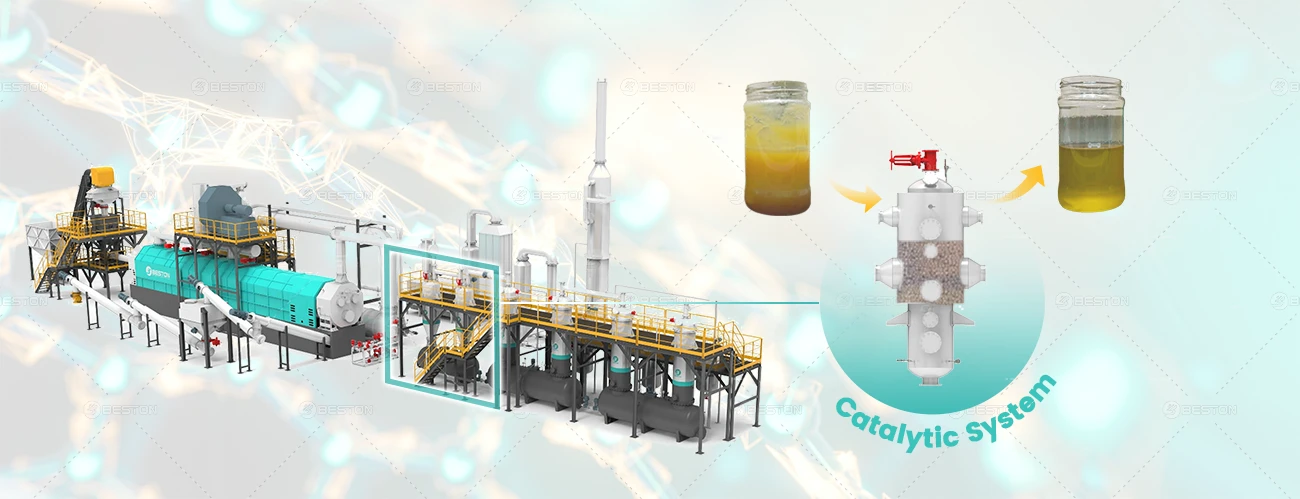Plastic pyrolysis oil has emerged as a promising alternative fuel and feedstock, yet its commercial viability hinges on refining its chemical stability, calorific value, and combustion performance. The pathway to higher-grade oil involves both upstream process control and downstream upgrading techniques. In a pyrolysis plant, even minor deviations in operational discipline can lead to significant variations in final oil properties.
Feedstock Preconditioning
The starting material dictates the achievable quality ceiling. Mixed plastics containing high levels of PVC or PET introduce chlorine, oxygenates, and moisture, which degrade oil quality. Systematic sorting to exclude halogenated plastics is essential. Additionally, reducing particle size ensures uniform thermal exposure and minimizes incomplete depolymerization. Pre-drying feedstock to a moisture content below 1% reduces water in the oil phase and mitigates acid formation during storage.
Reactor Temperature Optimization
The plastic to fuel machine window for most plastics lies between 450°C and 520°C. Temperatures below this range cause incomplete cracking, resulting in heavier fractions with high viscosity. Excessive heat, however, promotes secondary cracking into non-condensable gases, lowering liquid yield. Maintaining a stable mid-range temperature with minimal fluctuation ensures a higher proportion of desirable mid-chain hydrocarbons. Advanced temperature control systems, coupled with zoned heating, allow fine-tuning of cracking kinetics for targeted molecular distributions.

Controlled Residence Time
The vapor residence time in the reactor is a decisive factor in oil composition. Extended residence promotes secondary reactions that increase aromatic content while reducing aliphatic hydrocarbons. In certain applications, a moderate aromatic fraction improves fuel stability, but excessive levels can lead to soot formation during combustion. By integrating variable-speed condensers and precise gas flow regulation, a plastic pyrolysis machine can balance residence time to optimize the hydrocarbon profile.
Catalytic Upgrading During Pyrolysis
In-situ catalytic pyrolysis introduces catalysts such as zeolites, alumina-silica composites, or mesoporous materials directly into the reactor. These catalysts steer reaction pathways towards lighter, more uniform hydrocarbons while reducing oxygen and nitrogen contaminants. Catalysts with high acidity encourage deoxygenation, enhancing the oil’s stability and energy density. Regular regeneration or replacement of catalysts is critical to maintaining conversion efficiency.
Post-Condensation Refinement
Even with optimal primary pyrolysis conditions, post-processing remains indispensable. Fractional distillation allows separation of desirable fractions, removing heavy residues and unstable light ends. Hydrogenation processes can saturate olefins, improving oxidative stability and storage life. Adsorbent-based purification, using activated carbon or clay, can effectively remove trace impurities such as sulfur compounds, which are detrimental to both combustion performance and emissions compliance.
Gas Recycle Integration
Uncondensable gases generated during pyrolysis can be redirected as supplementary heating fuel, reducing reliance on external energy sources. However, these gases may also contain reactive species that, when reintroduced in controlled amounts, can influence cracking selectivity. By designing a closed-loop system with adjustable gas recirculation rates, the plant can fine-tune reaction chemistry to favor higher-value oil fractions.
Storage and Handling Protocols
Quality preservation extends beyond production. Exposure to oxygen, light, or elevated temperatures accelerates polymerization and sediment formation in pyrolysis oil. Storage tanks should be equipped with inert gas blanketing systems and kept at stable, cool temperatures. Stainless steel or epoxy-lined tanks mitigate metal-catalyzed degradation, while periodic sampling ensures that oil properties remain within specification over time.
Integrated Quality Control
Consistent monitoring at every stage — from feedstock intake to oil shipment — underpins sustainable quality improvement. Real-time spectroscopic analysis, combined with GC-MS profiling, provides immediate feedback to adjust operating parameters. By embedding analytical capability into the production line, a pyrolysis plant can proactively correct deviations rather than reacting after quality issues arise.
If you’d like, I can also prepare a parallel article focusing on cost-efficiency measures for these oil quality improvements without sacrificing output. That would pair well with this one.
Comments
No comments yet. Be the first to react!